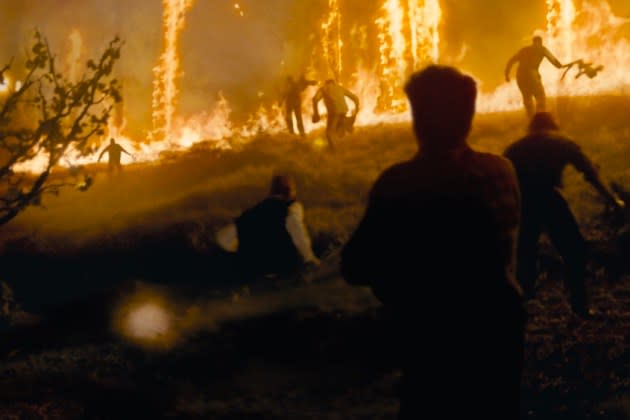‘The Fable’ Review: A Father Takes Flight in an Evocative Indian Drama

A tale of magical realism slowly stripped of its magic, Raam Reddy’s gorgeously photographed, politically subversive “The Fable” trades in idyllic memories, but reveals their hidden dimensions. Set in 1989, on a lush Himalayan orchard in northeastern India, Reddy’s second feature follows a family of four, whose patriarch runs the once-colonial estate with the help of local villagers in his employ. Everything seems pristine and picture perfect until the sudden discovery of a single burnt apple blossom tree, followed by more mysteriously torched bushes the following day, leading to fears and suspicions that trickle downhill.
The film’s unbroken opening shot goes quickly from unassuming to striking. It follows estate owner Dev (Manoj Bajpayee) along his morning routine, through his house with his wife Nandini (Priyanka Bose), his precocious son Juju (Awan Pookot) and his lively dogs. The camera then tracks him to a workshop outside, where Dev straps himself into some sort of harness. As he emerges from this outhouse, the sunlight illuminates a pair of enormous brown wings on his back, seemingly hand-crafted from wood hawk feathers. When he approaches a nearby mountainous ledge, he casually drops off it and takes flight, as though the wings were his own.
More from Variety
There’s a matter-of-fact quality to the film’s handful of fairytale elements. They exist mostly in the background, allowing for an intimate, mostly-English-language mood piece about Dev’s family to take center stage, when his teenage daughter Vanya (Hiral Sidhu) returns home from college for the chilly Himalayan summer.
“The Fable” was shot on 16mm film, which Reddy and cinematographer Sunil Borkar deploy with thoughtful purpose. It not only features the heavy grain and other imperfections of the stock, but maintains the scratching, the fading and the magenta hues of an old and battered film print. The very act of watching “The Fable” feels like rediscovering something once well-known, but lost to time, as childhood fables serve to process harsh realizations about the world.
Although set in 1989, the movie’s occasional voiceover — from a character left initially vague — looks back on these mysterious events from the present, 35 years later. While this narration initially frames “The Fable” as a retrospective on Dev’s family and their life of comfort, the slow unfurling of the plot goes hand-in-hand with the discovery of who is actually telling this story, and why.
Before long, the film’s gorgeous, postcard greenery becomes awash in smoke and darkness, as fires on the mountainside rage every other night, as Dev tries to figure out if someone from a nearby village has been harboring a grudge. Accusations fly in all directions. Some of these are aimed at a local nomadic tribe, who don’t speak, but wander the forests, humming and chanting at dusk. It so happens that Vanya is smitten with a young member of this group, introducing hints of a forbidden love story across class lines. However, Dev is far too preoccupied with his crusade to smoke out the culprit(s) to even acknowledge his daughter’s burgeoning sexuality, which Reddy captures with a gentle touch.
As the film goes on, superstitions alter the fabric of the estate and the surrounding lands, as Dev enlists the help of a local militarized police force to clamp down on any suspects, allowing his poor-but-loyal employees to be mistreated in the process. There’s a stark and noticeable moral descent across the movie’s mere two hours — about a week or two in the story — which can’t help but call into question what such a trajectory might look like over the course of 35 years.
As Dev, Bajpayee undergoes a stunning transformation. He goes from embodying a tangible paternal warmth to representing something abstract, callous and unsettlingly punitive. In his warped pursuit of justice, he sets into motion a financial and sociopolitical domino effect, shedding a light on his estate as a microcosm of a vast and unequal modern system. The very notions of land ownership and class are implicitly laid bare, not as systems which corrode from within despite good intentions, but which work as corrosively as intended.
In setting these political critiques against such stunning, pristine scenery, “The Fable” reckons with the question of whether cultural fears that take hold of communities are a natural state or a human construction stemming from power and social hegemony. The story unfolds on India’s eastern border, and its nomads are implicitly outsiders. That they so swiftly bear the brunt of the villagers’ suspicions is, unfortunately, not unexpected in a film so deeply connected to the contemporary Indian milieu and its right-wing authoritarian bent.
That this grim reality is so ferociously recalled by an ostensible fairytale is the source of “The Fable’s” irrepressible power, wielded by Reddy as though he were a cinematic sorcerer melding past and present, until memory, nostalgia and deeply held beliefs cease to be etched in stone. It is, in effect, a new and necessary way of seeing oneself, one’s childhood, one’s home.
Best of Variety
Sign up for Variety’s Newsletter. For the latest news, follow us on Facebook, Twitter, and Instagram.
Solve the daily Crossword

